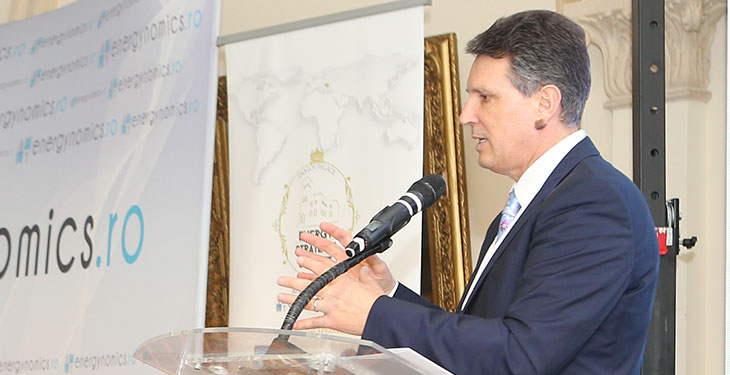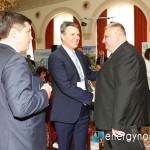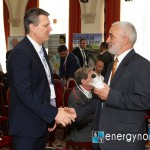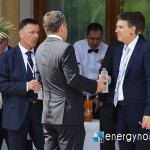This is the transcript of the message delivered by President of the Committee for Industries and Services at Romanian Parliament – Chamber of Deputies, during the 2016 Energy Strategy Summit, held on May 31 at Snagov Palace. For a sum-up of the main ideas, check our previous material: 27 essential ideas after Energy Strategy Summit 2016.
I want to start with what is natural, and that is to begin by thanking Varinia [Radu, founder of energynomics.ro], Gabriel [Avăcăriţei, editor energynomics.ro] and the whole energynomics.ro team for the extraordinary effort they made. I think this is characteristic for the younger generation, to be optimistic, always with a smile, to bring us all together in a common effort for a goal that has become a key target for all countries, but especially for Romania.
Secondly, I would like to allow me to have an approach strictly based on the key milestones of the situation in which we find ourselves. I will refer only to the key milestones, trying to start a debate from here. Glad to see all generations represented in this room, and this is a challenge!, because as Oscar Wilde put it: ” the old believe everything; the middle-aged suspect everything; the young know everything.” It’s hard to harmonize all these perspectives, but I think discussion and debate like this dedicated to the strategy and the target-objectives of Romania’s can give us the necessary guidelines.
Where are we? We are together in a new era in which we entered after COP21, in December 2015, in Paris. It is the biggest challenge of a period of transition from one era to another in the history of mankind, and this is my first point. Two, which is the key to this challenge? It seems that the whole community considers electricity as the key. What are the solutions? We come now to the third key point: a new technological revolution and a digital revolution. How to reach such goal, given that energy is unevenly distributed around the world, access is tiered, as costs are differentiated – extremely high for some, while for others they are somehow accessible. How do we harmonize the entire planet’ effort to achieve the same objective, namely the reinvention of energy?
The entire global community has concluded that we have to reinvent energy. For understanding this, let’s make a comparison in numbers between the United States – and here we had the high expertise from HE ambassador [Richard L.] Morningstar -, European Union and Romania. We have to, in the landscape painted by the figures, we, as Romanians, we have to dedicate five minutes solely to the Romanian national interests but from an integrated perspective, and not in terms of isolation. The European Union imports 53% of its energy raw resources and has the highest energy bill for energy it uses, compared to all countries in the world, more than 400 billion euros, which is 1.11 billion euros a day. In those circumstances, an increase of only 1% in saved natural gas leads to a 2.6% decrease in imports. 75% of all households in the European Union are energy inefficient. Each year, 120 billion euro go to subsidies for energy in Europe, and they are often unjustified subsidies. Drawing a parallel with the United States, we pay the most expensive energy bill in the world, 30% more than the cost of energy in the United States and twice more in respect with the price of natural gas in the United States.
As about renewable energy, four German lands have already had 56% share of renewable energy in total energy consumption. In Portugal, this share is 45%, 36% in Denmark and the trend is for these shares to rise. Romania in part of this landscape, the latest data presented by the Ministry of Energy show, with a share of around 24-26%, also on the rise. 18% of the total energy consumption in the European Union comes from renewables, while renewables contribution in total electricity generation is 28%.
Unites States assumed as a target to be able to get rid of coal, nuclear and oil by 2050. Among their strategic objectives, US include climate change, energy security, energy poverty and nuclear non-proliferation. In Europe, the strategic objectives are durability, security, competitiveness. Here we have the first notable difference between the two major areas of the world. Europe is facing a major challenge pertaining to competitiveness, although it has 40% of all patents on energy efficiency and renewable energy globally, while providing two million jobs in these sectors. As an aside, in the photovoltaic sector solely, Germany has more jobs than the United States has in the steel production, and the trend is more jobs to be created! How, under these circumstances, can we reclaim our competitiveness and to enter the global market, a global market where more than 30% of the products are highly energy intensive? Europe should continue to reduce energy intensity and increase its efficiency. Hence, two strategic landmarks to be taken into consideration. The United States said something like this: “75% of oil consumption is transportation, and buildings consume 75% of all electricity. These two areas are critical for us in terms of technological revolution.” The EU has identified the same two areas, only that in the European Union 94% of oil is consumed in transportation, and 90% of oil is imported. The European Union has arrived to import over 60% of the natural gas it uses, over 90% of the oil it uses, and almost 100% of all uranium, while 36% of all its energy raw resources are imported from Russia. You can have security as a key objective, but when you are 53% dependent on imported energy raw resources, energy security is nothing but a fairytale, if you fail to diminish these imports. We note that, on the one hand, the European Union has chosen some strategic landmarks and said something like that: “we will invest heavily in new technology plan for innovation, research, and grant each year 200 million to this area.” The European Union has pledged investments of one billion euro solely for energy, up to 2020. In the technology field, the European Union has chosen some key points, namely renewable energy, the consumer – no longer just consumer, but prosumer – , energy efficiency, transportation, and nuclear. In terms of energy strategy, beside the Technological Plan, attention was turned to security, solidarity, trust and decarbonisation. What stands out? These two brand new approaches based on consumer-prosumer and, respectively, high efficiency technologies. It was a question earlier from the audience about the role of the consumer. Suddenly, the whole idea for a new energy is based on the consumer to whom, through this investment plan, high efficiency technologies are committed to and to whom support is provided for entering the energy efficiency program, by means of some already prepared financing schemes, in a strategic UE program. In the United States, this focus on the technological revolution has resulted in a classification of all buildings on energy efficiency levels, labeled from silver, gold, to platinum, and an association of building owners dedicated to this field, has already appeared, to offer authorization, and certification based on efficiency categories. What was the instrument they used? Subsidies. A building entering the certification categories benefits of a 33% support through subsidies.
Also, the energy efficiency measures for vehicles have tripled the speed of acceleration in efficiency for cars, and the sector was directed to electricity. Steel industry is currently facing the biggest challenge, because it started to be replaced, at least in the transportation, in the automotive sector, with carbon fiber. And this, provided that the car fleet is expected to grow by 76%, transportation by trucks, with an advance of 113%, while the air transportation might increase by 68%. So, the first challenge of the energy system is how to disengage from the present dependence on oil, in order to move to electricity. This implies on the one hand storage capacities, but also rescaling networks for operating in an insular, isolated and interconnected system.
Back to Romania, we can have a discussion starting from the following. The European Union is more than 60% dependent on imported natural gas, in Romania this dependency is of 10-15%, even less this year. A 94% oil dependency in the EU, while between 50 and 60% in our country. For the time being, we do not need nuclear imports, but the process will lead to some forms of imports, although I would have preferred this not to happen, and us to use our own resources.
There are several myths that have fallen with the transition to the new era. The myth of peak oil consumption and highest prices for oil crashed altogether with the recent sudden fall in oil prices, an evolution which took the entire planet by surprise. This myth has fallen. Now we are in a situation the Director General of the International Energy Agency anticipated even since 2008, when he asked us to pay attention we should leave oil before it leaved us. We see now that oil has come to stop being competitive, before becoming too expensive and inaccessible. Today oil it is affordable, but it is not competitive, although not inaccessible, because of high price. The second myth is natural gas exhaustion. Natural gas has become the king of energy resources and extended its lifespan from 50 to 250 years. Thus, if Romania would have to talk strategically about building its own energy mix, what might be the priority for the Romanian energy mix? We have our place the general landscape of European and global mix, with renewable energy, natural gas, nuclear, hydro. What about coal? With coal, we detain a resource that might have an over 100 years future, if we were to use it in electricity generation capacities, other than those we use today. Present investments in technology allow transformation of sugar cane into biodiesel that can be sold at smaller prices than the petroleum products. I believe technology could provide a solution to coal gasification, with mature technological and commercial solutions, with minimal impact on environment.
We have a chance for coal to continue to play an important role in the energy mix, and the solution once again comes from technology. From this point of view, Romania is somehow different when compared to the European macrocosm. I liked how His Excellency the Ambassador [Richard L.] Morningstar has put it, that Romania is a microcosm of Europe. That’s how it is! However, Romania has some more favorable features when compared to the European landscape, as it is one of the first three countries in Europe in regard with energy independence.
However, we have some vulnerabilities that could be turned into opportunities. What are our weaknesses? Outdated and polluting energy generation capacities, which require massive investments for replacement. Classic energy production in Romania has three more decades of smoothly operation. Time enough to make the transition to new technologies. We already see how they, even without subsidies, are ready to enter the Romanian market. New technologies are suddenly becoming support and benchmark in terms of energy, at regional scale.
I will mention the example of technology for biomass, with a key role in the new energy strategy. We always have to look at the strategic milestones from the investor’s perspective, for no strategy is relevant, if it is not relevant to the investor. Investors from the United States, for example, say they are interested in Romanian biomass, in particular, but we need to give them a serious partner and predictable renewable legislation.
Thus, we have identified the key themes, and they are: electricity, transport, integrative design and business models adapted to the new energy concepts. These are the strategic priorities, that may be also ordered in terms of priority for the investors’ perspective: energy efficiency, renewable energy, natural gas, nuclear power and hydropower. In biomass, there are already high efficiency technology, and in Romania we have huge areas of land which is biodegraded. There are 423,000 hectares in a process of desertification in the South of the country, from Oltenia to Braila, and wetlands and floodplains. This land can alone provide the solution for hot water and heating for all Romanian cities.
In conclusion, we have entered into a new era and all the solutions are ahead of us: technological revolution, digital revolution and better legislative approaches, both in laws and regulations. There are some unprecedented challenges in this respect, and I can tell you today that we have completed the legislation for the Black Sea offshore. Sometime during the first half of June, it will be approved by Parliament. On energy efficiency, full transposition of European Directive will be finalized in the first half of June. All the legislative modifications required by the BRUA project have entered into an accelerated process of approval, all due to end up in June, in Parliament. We have to be more careful with the Ministry of Economy! There are a few people there who did not understand this priority and they must adapt quickly because BRUA is a project of common interest with our European partners. Though everyone acquiesced on this, we are in a very delicate and difficult phase with amending Law 123, the framework for electricity. In respect with biomass, we have a new bill registered in Parliament for trying to create a niche for the extraordinary opportunities that Romania has.
All research from all around the world, all funds are dedicated to this new forms of energy, which are no longer extracted from underground, but are floating somewhere above the ground, which are no longer local, but global, no longer polluting, but clean, no longer expensive, but practically free. This is the challenge that we are all basically forced to adapt.




